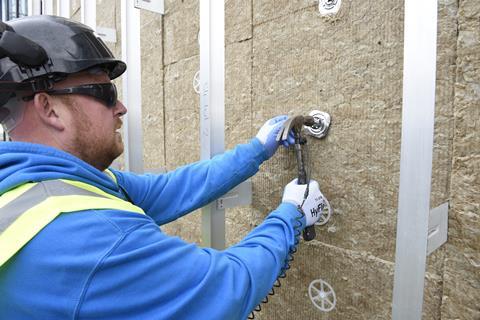The last few years have seen several updates to Building Regulation guidance and as product choice comes under even greater scrutiny, streamlining the process has never been more important. Luke Davies explains

As building standards continue to rise and regulation guidance becomes more complex, specifying the right combination of products for rainscreen applications is more challenging than ever. Luke Davies, rock mineral wool product manager at Knauf Insulation, explains how to streamline the specification process without compromising on real-world performance.
Higher standards
The last few years have seen several updates to Building Regulation guidance, including Approved Document L and Approved Document B, which raised the standards for thermal performance and fire safety, respectively.
More recently, the Building Safety Act has introduced measures that will have a significant impact on rainscreen specifications. Whilst the legislation applies to all residential properties, there is a particular focus on higher-risk buildings. These are described as buildings over seven storeys or 18m tall, that contain at least two residential units or are used as care homes or hospitals.
Three new Gateways have been introduced, as ‘checkpoints’ for the Health and Safety Executive to assess Building Regulation compliance. This forms part of the required ‘golden thread of information’ – a digital record showing how the building was designed and built. Retrospective liability has also been increased to 30 years, so developers must be confident in the materials and systems they specify.
In short, the level of accountability has increased throughout the entire supply chain, from design to ongoing maintenance of the completed build.

Unfortunately, a fully compliant design does not always translate into the same level of as-built performance.
Inaccurate U-value calculations or poor installation can compromise insulation’s thermal and fire safety performance.
Similarly, products tested separately might not work together as intended.
So, how can developers ensure their designs perform in the real world, whilst streamlining the specification process?
Precise calculations
Turning specified U-values into as-built performance requires calculations that are as accurate as possible. Simplified calculations are not recommended for rainscreen facade systems because they apply a blanket correction factor to account for things like penetrations from the steel frame. This can result in inaccurate specifications and compromised performance.
By insisting on 3D U-value calculations from the insulation manufacturer, developers can account for the impact of those penetrations more accurately, giving them a better indication of as-built performance. To streamline the process, it’s a good idea to request an in-depth report detailing what components were included in the calculations. This can be passed on to the supply chain, so they know how changes to the specification could affect the U-values, helping to protect the design.

Robust installation
To deliver its specified thermal and fire safety performance, insulation must be correctly installed, with minimal gaps. Rigid boards present a challenge because no matter how skilled the installer is, they won’t sit flush against a cavity unless it is perfectly uniform and flat. Mineral wool insulation is easier to install correctly because it is flexible, allowing it to maintain close contact with the substrate. Where slabs meet the ends also ‘knit’ together, minimising gaps and maximising thermal performance.
Cavity barriers pose another potential challenge to thermal performance. Traditionally, they require the insulation to be cut post-installation; an intricate process that can result in unintentional air gaps. Knauf Insulation has addressed that challenge with Rocksilk® RainScreen FFCB, a cavity barrier that can be fixed to the face of the sheathing insulation in masonry facades. It’s quicker and easier to fit correctly and because the insulation doesn’t need to be cut post-installation, it reduces the risk of gaps that could compromise performance. It also saves time during specification because it’s part of a certified system solution with insulation and fixings, so there is no need to source each product individually.

System specifications
Developers need to know that individual products in a build will work together as intended and when it comes to fire safety, there is no room for doubt.
One way to help mitigate this risk is to specify a full system solution. These are systems including cavity barriers, sheathing insulation, and fixings that have been tested both individually and together.
For example, Knauf Insulation recently launched Rocksilk® RainScreen Cavity Systems, which feature insulation with a Euroclass A1 reaction to fire classification, making them suitable for every height and use of building. The systems also include open state cavity barriers with an intumescent strip, a closed state cavity barrier, and further additions to the Rocksilk® RainScreen FFCB range. Systems like these allow developers to choose a solution that best meets their fire performance needs, confident it has been tested to the relevant standards.
The construction industry will continue to evolve over the coming years and product choice will come under even greater scrutiny. Meeting these tightening requirements will mean streamlining the specification process and choosing products based on full system testing, accurate calculations, and as-built performance.
Learn more about Rocksilk® RainScreen Cavity Systems. Contact Knauf Insulation here to request a free 3D U-value calculation.









